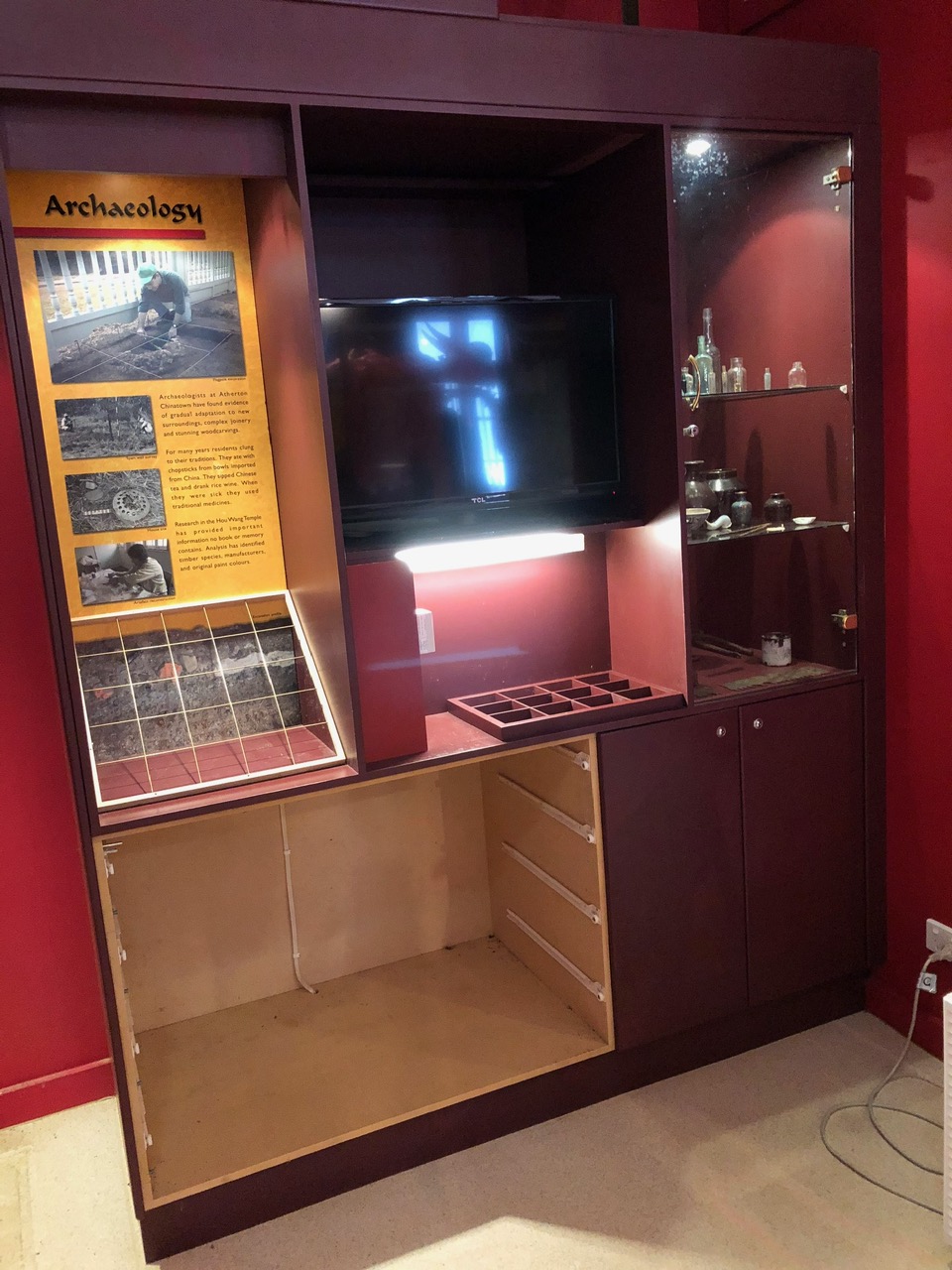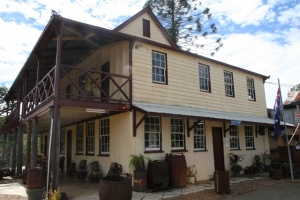Blog Archives
Reopening Atherton Chinatown

After four months of closure due to COVID 19, the National Trust of Queensland (NTQ) have been preparing to reopen the Hou Wang Temple and museum displays in the Tableland Regional Council’s Old Post Office Gallery in Atherton. Like other cultural venues across the state, reopening is not as simple as just unlocking the doors and welcoming visitors. Facilities need to be prepared in line with strict regulations and COVID plans, and thoroughly cleaned. An opening date is planned for early August.
For Atherton Chinatown, this has meant addressing the effects of an extended period of rain which had caused mould issues in the gallery and the collection area. To help out, MDOs Ewen McPhee and Dr Jo Wills spent four days helping NTQ workers and volunteers undertake a ‘deep clean’ and refresh of the site. In the process we learnt more about the collection, the temple and Chinese history. We also got to know some of the amazing volunteers who proudly share Atherton Chinatown’s history with visitors throughout the year.
Preparing the Gallery
NTQ representative and archaeologist, Gordon Grimwade, photographed each display section as a reference point for re installation. We then dismantled each display, making sure to link the case, perspex cover and contents by a temporary number. Objects were placed on calico lined trestle tables in their display groupings to avoid any confusion. They were checked for mould or other problems and cleaned with either a dry cloth, a solution of vinegar and water, or lightly vacuumed using a micro attachment. Volunteers removed and cleaned all of the large timber backed images that were mounted on the display (back and front) and the free standing interpretation panels. Ewen and I removed some multimedia items that were no longer working, and cleaned and relined drawers in the display that contained collection items. The empty gallery was then cleaned by professional cleaners.
The installation process involved Ewen rehanging all of the agricultural instruments making sure they were at once secure and accessible. Jo reset each of the display cases and, because of the poor condition of the labels, created new foam core labels for all items (thanks to Tablelands Regional Gallery and Council staff for their help with materials). We also sought opportunities to make the extraordinary portraits in the gallery more accessible for visitors by removing obstacles and creating a clear line of sight. The result is a gallery that looks refreshed and reinvigorated, and that is easy to manage for the volunteers into the future.
Refreshing the Temple

Atherton’s Hou Wang Temple is an extraordinary and beautiful building made from black bean, red cedar and tin. It is listed on the Queensland Heritage Register and is the only surviving timber and iron temple in Queensland One of the volunteers, Graham, has been taking visitors through it for the past 17 years, and it was a pleasure to listen to him share his knowledge of the history and of Chinese symbolism.
Despite its charms, the temple does present ongoing maintenance challenges, particularly regarding mould and pest control. Gordon, along with volunteers Neil and Graham, spent considerable time cleaning mould and residue from the fence. Ewen worked to bring the interior of the temple back to life – mostly with vacuuming and cleaning the floors. In an attempt to reduce vermin access, he and Graham placed steel wool in gaps that were identified – this will hopefully reduce the damage and mess within the temple this while pest control solutions are explored.
A new collection room
The project also gave Gordon and the volunteers a chance to plan how their collection room, located in one of the back rooms of the post office, would operate. Lucy and Terry spent two days painting boards for the new shelving system. The room will be a dedicated collection space for storage, cataloguing and other collection management activities. Items that had to be moved temporarily into the temple meeting room can now be stored more appropriately.
Our thanks and appreciation for the help and good humour to all the volunteers, and to Gordon and Christine Grimwade who coordinated the weeks work.
Volunteers bring Cairns’ Chinese heritage to life on Vimeo…
For those of you not familiar with Cairns’ Chinese heritage, here is a chance for a sneak peak into CADCAI’s (Cairns and District Chinese Association Inc) collection rooms and activities. Recently, four volunteers from CADCAI – Julie, Jackie, Ann and Emma – participated in a video making workshop run by ABC Open in Cairns. Over two days they scripted, filmed and produced a short promotional clip designed to entice visitors to their rooms in Cairns.
Their production showcases the region’s Chinese history and promotes the work they do to preserve the remarkable Lit Sung Goong Temple Collection. Salvaged by members of the Cairns Temple Society in 1964, this rare and beautiful collection comprises more than 250 individual objects. The Lit Sung Goong Temple Collection is representative of late 19th century Southern Chinse religious artefact production and is one of the most complete and virtually intact collections of Imperial Chinese temple fittings in Australia.
Follow the link to see the video CADCAI’s volunteers produced during the workshop: http://vimeo.com/71074565/
Queensland Migration Heritage Hub

Russian immigrants tending their cotton crop, Queensland (undated). John Oxley Library, State Library of Queensland
The Queensland Migration Heritage Hub is a website that brings together migration heritage resources including research material, images, listings of heritage sites, archival information and records, a wide variety of useful links, and migration stories of Queenslanders. Have a look at the website here to start your research.
Irvinebank in situ: making the most of “sense of place”
How many museums located in historic buildings count the building as their most significant item? And how many make the most of the stories associated with fabric and use through interpretation and strategic collecting?
Loudoun House Museum does. It’s located in Irvinebank, a small town near Herberton in the Atherton Tablelands that is renowned for its link to 1880s mining magnate, John Moffat. Strategically sited on the top of the hill as you enter Irvinebank from the east, Loudoun House is North Queensland’s oldest high-set timber and corrugated iron house and is listed on the Queensland Heritage Register.
Although some of the original furniture has been removed, Moffat’s original desk and chair are still located in his study. The subtle reminders of how the building was used, as well as its physical association with other Irvinebank buildings through both location, communicate a strong sense of place and of town’s importance during its zenith.
Jo Wills, MDO for FNQ
Mossman Shire Hall 75th Anniversary Exhibition
In June 1937, Mossman celebrated the opening of it’s new shire hall with an Opening Ball. Seventy five years later, Cairns Regional Council will celebrate the anniversary of this Queensland Heritage Register-listed building (and its refurbishment this year) with an old time dance and a small exhibition on 22 June 2012 .
Built as part of the Queensland Government Unemployment Relief Scheme during the 1930s, Mossmand Shire Hall was designed by notable north Queensland architectural firm, Hill and Taylor. Their work can be seen in a number of buildings in Mossman, and in many towns across the region.
In preparation for the exhibition, Council staff in Mossman have been busy talking to locals and gathering photographs, newspaper articles, dresses, awards and other Hall-related memorabilia. The material will be used to showcase the buildings history and community use. Exhibitions that draw on community artefacts, anecdotes and images are a great way of exploring the significance of heritage buildings.












